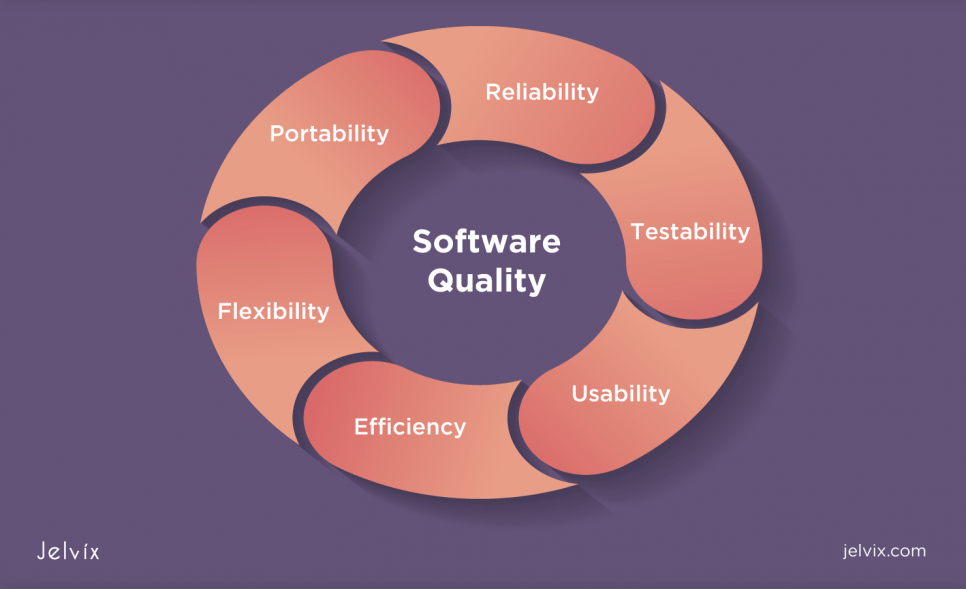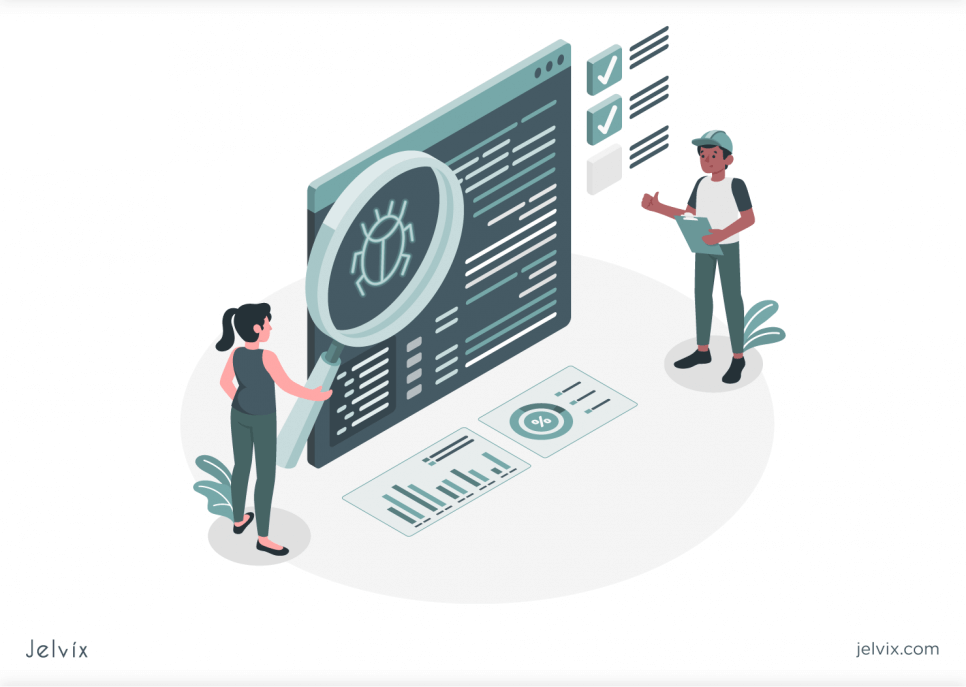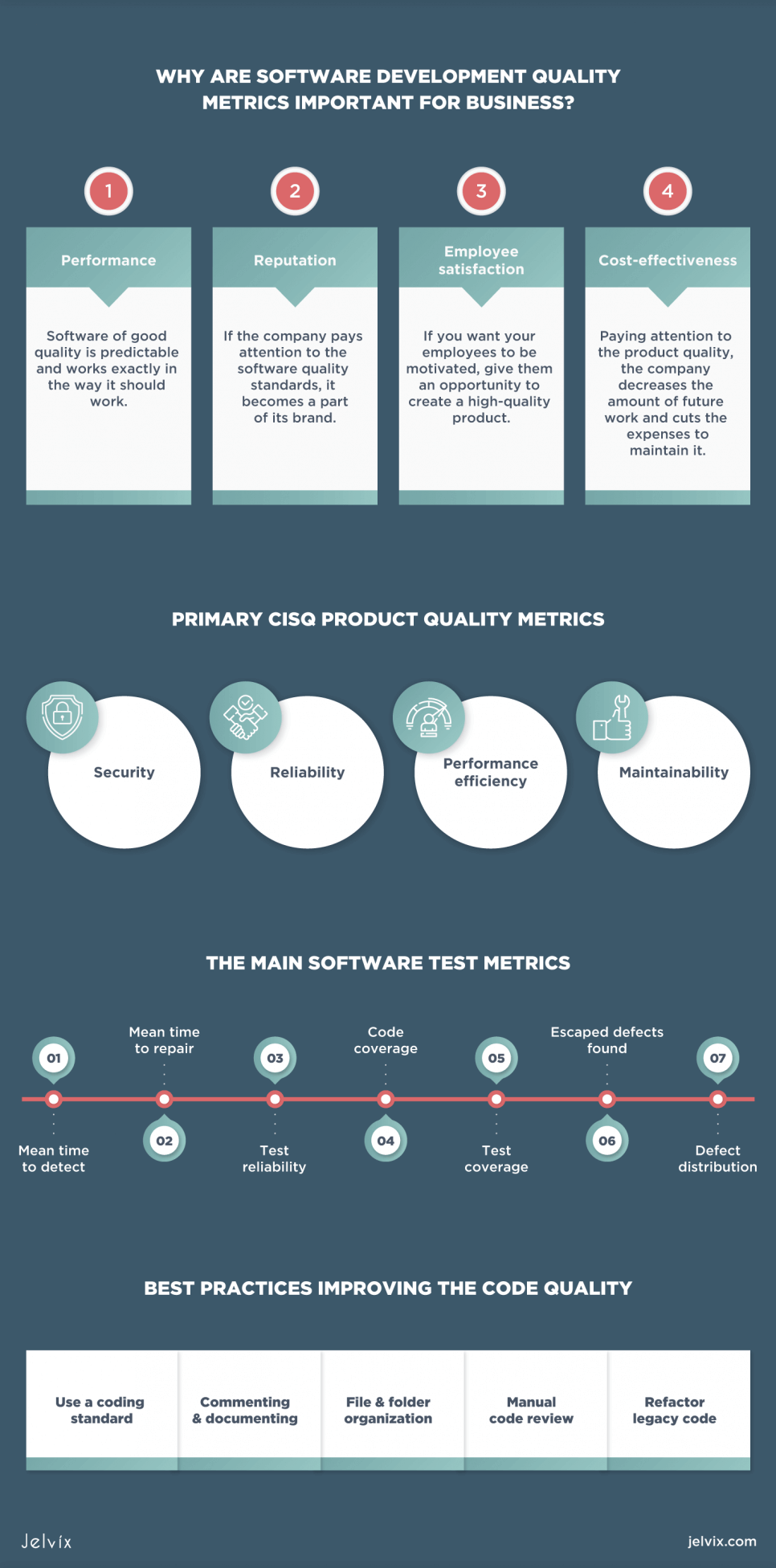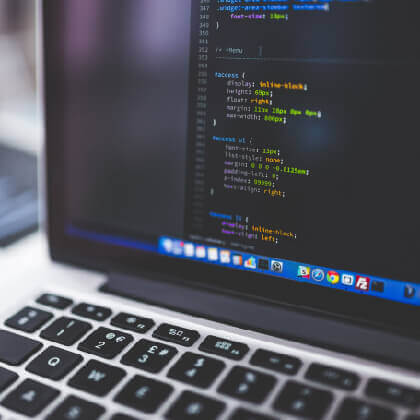The tempos of the software development process are growing every hour. Amazon uses to deploy software updates through their Apollo deployment service every 11.7 seconds. Etsy has a fully automated deployment pipeline that does about 50 deployments a day.
With deadlines becoming tougher every day, the product quality requirements are growing as well. Under these conditions, maintaining and constantly improving the product quality becomes a matter of primary importance.
In this article, we pay attention to the importance of software quality management. You will learn about the quality metrics used for assessing the software performance and ways to maintain the quality on the proper level. We also discuss the best practices of maintaining the software quality that the Jelvix team follows during product development for our customers.
How to Measure Software Quality?
Software measurement checks if the software solution satisfies its requirements. The requirements can be classified as functional or non-functional.
Functional Requirements
They specify the basic software functionalities and are necessarily included in the contract between the customer and the software development company. In other words, the functional requirements describe the things that will be available for the end-users. Here are the examples of functional requirements:
- Usability
- Performance
- The way of performing the operations, data processing
- Transaction processing
- Reporting system errors
- Administrative functions, authorization levels
- Certification and legal requirements, verification
Non-functional Requirements
They aren’t concerned with the specific features but define how the whole system should work. Although the end-users can’t see it, this is what determines the product quality. Failure to meet them will result in poor performance, security breaches, and other unpleasant consequences.
While functional bugs can be easily fixed, system problems always result in serious money and reputational losses. If a system failure occurs, the customers will likely cease using the product and choose the competitor’s one. It will take a lot of resources to fix the system issues, perform damage control and return customer loyalty.
Why are Software Development Quality Metrics Important for Business?
Product quality is the main thing that influences customer loyalty and the success of the entire product. But what is a good quality of software? We already know about functional and non-functional requirements to the software solutions, but how are they connected with software quality factors? Let’s speak about the characteristics of metrics of code quality and the impact on the business side.
Performance
Software of good quality is predictable. Being appropriately written, it works exactly in the way it should work. There are no variations in productivity, no need to rewrite, no urgency, and it is easy to manage. On the contrary, the product of low quality is unpredictable and may perform undesirable actions that can lead to unpleasant consequences.
Reputation
If the company pays attention to the software quality standards, it becomes a part of its brand. The product has a high level of security, smooth performance without glitches or other issues. Customers trust it; they want to use this product particularly and have high expectations.
Bad code quality can result in security breaches and money losses both for the company and their client. According to the CISQ report, command and query responsibility segregation issues cost companies about $2.08 trillion across all sectors.
Employee Satisfaction
If you want your employees to be motivated, give them an opportunity to create a high-quality product. When the team is excited about their work, it drives a higher level of productivity and the willingness for self-development. On the contrary, poor-quality products, tight deadlines, and the need to redo the work lead to demoralization of the team and worse work.
Cost-Effectiveness
From the business point of view, the essential criteria of product success are its return of investments (ROI). Generally, software maintenance may require 40-80% of the average budget. Paying attention to the product quality, the company decreases the amount of future work and cuts the expenses to maintain it.
Types of Software Quality Metrics
Now we will speak about the major code quality metrics. Our work is based on CISQ code quality standards and pays attention to both functional and non-functional standards.
Product Quality
These are four primary CISQ product quality metrics. They regulate how the software should perform both from the client and server sides.
Reliability
Software downtime causes financial losses, increases security risks, and lowers customer satisfaction. To measure and reduce the risk of failure, we assess the reliability of a software product.
Reliable software doesn’t fail that often, and it is easily recovered when downtime occurs. In modern software development, containerized microservices give the possibility to automatically redeploy software in case of failure, shortening the deployment of the product.
How do we assess reliability?
- Production incidents
The system reliability can be measured by the number of identified high-priority bugs that are already in production.
- Reliability testing
With the help of load testing and regression testing, we check how the software functions while the team is making changes.
- Reliability evaluation
These are in-depth tests handled while constructing an operational environment simulating the real one. QA engineers test how the software works in its steady state and under tougher conditions with more requests in the operational environment.
- Average failure rate
Measuring an average number of software failures per unit or user.
Performance
The main criteria of software performance are database and server functioning, scalability, and data processing latency. Today, it becomes critical for web, and mobile applications since users expect quick system response and become frustrated if any delays occur.
How do we access performance?
- Load testing
Testing the system behavior under a certain amount of load, for example, 5000 concurrent users.
- Stress testing
It’s necessary for understanding the upper limit of system capacity, with which it is still able to function normally.
Here we use prolonged load to understand when the system performance is going down.
- Performance monitoring
Checking the work from the user perspective ensures that the application provides the necessary level of service and identifies the performance issues.
Security
These software metrics show how easy it will be for hackers to breach the software, cause downtime, or get unauthorized access to sensitive information. The central concept in software security is vulnerabilities — errors in the code that can result in a breach. The number and severity of vulnerabilities is an indicator of software security.
How do we assess security?
- Number of vulnerabilities
It is possible to detect them using automated scanning tools. The number of spotted vulnerabilities is a positive or negative indicator of app security.
- Time till resolution
How long does it take to release a fix or patch since the vulnerability has been spotted?
- Number and severity of security incidents
Actual statistics on the number and duration of attacks, how they affected the users, and how long it took to fix them.
Maintainability
These quality metrics define the ease with adapting the software to other purposes, porting it between the environments, transferring it to a different development team. Maintainability and code quality go together so that we will speak about it below.
Code Quality
It is difficult to create code quality metrics. Still, developers from all over the world agree that good code written according to the coding standards is readable, reusable, and well-documented. There is no duplication; it uses the resources efficiently, is covered with unit tests, and complies with the best security practices. Here are the criteria for measuring code quality.
Number of lines
This metric is straightforward but affects the system maintainability. The more code lines the software has, the more difficult its maintenance is, and the possibility of code issues is higher as well.
Static code analysis
Checking the code with automatic tools helps to ensure that the code is compliant with the industry standards. This is done directly on code IDE without launching the software.
Software complexity metrics
Complex code is more difficult to maintain, so there are several ways to measure the software complexity. Here you can read how to measure cyclomatic complexity metrics.
Testability
It helps to see how the software responds to testing, how well you can control and automate the testing, isolate a particular unit, etc. If the software quality measures are good, we need fewer test cases to spot an error, and the chance to release it to the end-user is lower as well. Size, complexity, and number of coding lines — all these things affect testability as well.
Portability
This metric shows if you can use the software in various environments. There are no automated tools for checking the portability. Still, it’s the best option to regularly test the code on different development platforms without waiting for the end of development and release to end-users.
Reusability
Use the static analyzer to spot the interdependencies and check if the code can be used again. It depends on the number of interdependencies, and a static analyzer can help identify if modularity or loose coupling is available.
How to Measure Software Quality and Maintain It
It is always easier to prevent the issues by releasing high-quality software than to deal with the errors that come out after the release. We will tell you about the practices the Jelvix team uses for delivering high-quality software solutions.
Development Best Practices
Our developers aim to deliver high-quality code with minimal bugs (minor ones are inevitable). Writing the code, we cover it with unit tests, spot and fix the errors at the earliest stage. To ensure the code quality, we use the following three-stage strategy.
Static code analysis
It examines the code without launching it and checks it according to the coding standards. While unit testing can’t predict all the possible execution paths, the static analyzer can. It checks the code according to your criteria and indicates the errors that can be potential vulnerabilities.
P2P reviews
We use Git and Bitbucket for version control and remote repository management. There is a branching strategy in Git and developers commit their code to Bitbucket. When the feature is completed, the teammates act as code reviewers. The new feature will be merged to the development branch only after the reviewers approve it.
Reviews by Senior/Lead developers
The previous stage helps to filter out and fix the majority of common mistakes. At this stage, experienced developers analyze the code and provide feedback related to architecture and best coding practices. This encourages the team to deal with a similar task in more high-level problems and constantly improve their code quality.
The Main Software Test Metrics
The goal of quality assurance is to ensure the highest possible quality of the software product. Now we will speak about the quality assurance metrics the QA engineers use for code evaluation.
- Mean time to detect (MTTD)
The sooner you discover the issue, the easier and cheaper it will be to fix it. These metrics show how much time it will take to discover the issue.
- Mean time to repair (MTTR)
As it is clear from the title, these metrics show how much time the organization will need to fix the issue. It is calculated by finding the total amount of downtime, counting the number of incidents, and dividing the first figure by the second one.
- Test reliability
Test reliability refers to the percentage of tests that provide helpful feedback.
- Code coverage
This is the percentage of the codebase that has been covered by testing. The most useful way to calculate the code is branch coverage since it helps test scenarios with conditional branching (if-statements) inside the code.
- Test coverage
While code coverage refers to the percentage of the codebase covered by unit tests, it helps make sure that you used various types of tests to assess the product, not only unit tests.
- Escaped defects found
These metrics show the number of defects found in production, i.e., the ones that “escaped” your QA strategy.
- Defect distribution
Here we assess the bugs according to different criteria: severity, area of the application, testing type, etc.
Learn more about the differences between quality assurance vs quality control common approaches, risks, and similarities.
Best Practices Improving the Code Quality
Apart from testing automated tools for code analysis and code review, we use the common best practices to help our developers write high-quality code even before it comes to multiple checkpoints.
Use a Coding Standard
To ensure good code quality, our developers apply coding standards. They make sure everyone uses the same coding style, improves the consistency and readability of the code. Key benefits of using a coding standard are:
- The code is compliant with industry standards!
- All developers write the code in a particular style;
- Better software security from the very beginning;
- Easier software testing;
- Reduced development costs, accelerated time to market.
Commenting & Documenting
To help other developers understand your code better, it is a good practice to put the comments and properly document your code.
Documentation will be used for someone who can use your source code but is unlikely to read it carefully. When building open-source software, documentation is a must-have.
The comments are written for the developers who are likely to maintain or refactor your code.
File & Folder Organization
Technically, it is possible to write an entire application in a single file. Here we give some tips on file organization within the project.
- The names of files and folders should be self-explanatory;
- Organize everything within one directory — this makes it easier to find a new file;
- Separate raw data from derived data;
- Separate the data from the code;
- Write explanatory files: README, Changelog, etc. Describe the project organization there and keep them updated.
Manual Code Review
With all automation tools, manual code reviews are still crucial for quality control. Static analysis and testing can check if the code has bugs and vulnerabilities, but they can’t control the design and functionality. Properly done, they not only improve the application quality but develop the overall skills of the developers.
Refactor Legacy Code
If the software was written a long time ago, its codebase possibly needs improvement. Code refactoring will help to clean up the application code and make it easier to maintain. You won’t be able to improve the legacy code in one sprint, so it’s better to do this gradually. Here we will give you some tips on refactoring:
- Refactor the code that has already been covered by unit tests;
- Start refactoring with the deepest point of the code;
- To ensure you haven’t broken anything, test the code after refactoring;
- Have a backup to revert to the previous version.
Conclusion
If you need a product that will satisfy your customers, it is better to pay attention to the quality from the very beginning. Our team has high standards and pays attention to product quality at all stages of development.
Got any idea to bring to life? Contact our team for a free consultation.
Need a qualified team?
Use our top talent pool to get your business to the next level.
















